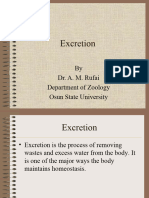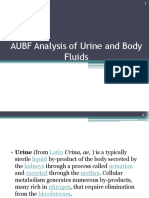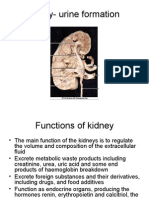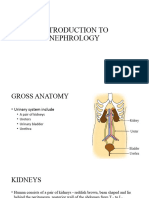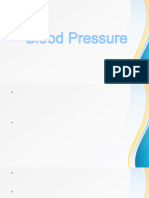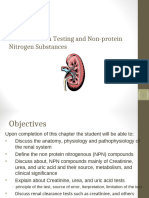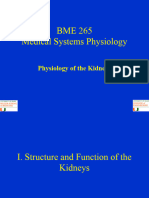17: Kidney and Nephronal Physiology: Key Terms Nephron Anatomy and Function
17: Kidney and Nephronal Physiology: Key Terms Nephron Anatomy and Function
Uploaded by
Elisa SalakayCopyright:
Available Formats
17: Kidney and Nephronal Physiology: Key Terms Nephron Anatomy and Function
17: Kidney and Nephronal Physiology: Key Terms Nephron Anatomy and Function
Uploaded by
Elisa SalakayOriginal Description:
Original Title
Copyright
Available Formats
Share this document
Did you find this document useful?
Is this content inappropriate?
Copyright:
Available Formats
17: Kidney and Nephronal Physiology: Key Terms Nephron Anatomy and Function
17: Kidney and Nephronal Physiology: Key Terms Nephron Anatomy and Function
Uploaded by
Elisa SalakayCopyright:
Available Formats
Human Physiology Core Concept Cheat Sheet
17: Kidney and Nephronal Physiology
Key Terms
Ureter: are hollow, muscular tubes. The filtrate fluid drains from the kidneys to the bladder. Bladder: functions by collecting and storing urine until it is eliminated from the body. Urethra: is a hollow tube leading from the bladder to the body surface, for the external elimination of urine. Nephron: There are over 1 million in each kidney. All the nephrons drain towards the center of the kidney into the collecting duct system. The nephron perfoms almost all of the kidneys functions, including reabsorption and secretion of certain solutes and ions. Minor calyx: receives drainage from nephron. Renal pelvis: gathers fluid from major calyx before draining into ureters. Vasa recta: blood vessels around Loop of Henle, These vessels function to maintain the gradients necessary for countercurrent exchange. Loop of Henle: The Loop of Henle can be divided into 2 functional regions: Descending Limb and the Ascending Limb. In the Descending Limb, fluid travels down the descending limb towards the medulla. In the Ascending Limb, fluid travels towards the cortex. In this region of the nephron, Na+ and Cl- are actively transported out of the limb. This leads to dilute or hypo-osmotic fluid entering the collecting tubule. Countercurrent mechanism: establishes osmolarity gradient from cortex (300 mOsm) to medulla (1200 mOsm); enables urine to be concentrated. Tubular Maximum: maximal level of a substance to be transported by the nephrons. Micturition Reflex: emptying of the bladder, involves spinal cord reflex, as well as conscious control. Diabetes: In uncontrolled diabetes, higher than normal blood glucose levels occur. This leads to greater than normal glucose being filtered in the glomerulus. Therefore, glucose levels in the nephron exceed tubular maximum and this causes glucose to be excreted in the urine. The excreted glucose can be easily detected on urine test strips. Glomerulus: specialized capillary; filters blood into nephron; pore size determines what passes into nephron. Bowmans Capsule: membrane surrounding glomerulus; captures all filtrate, which then drains into the proximal tubule
Nephron Anatomy and Function
Proximal tubule: primary reabsorption area; has microvilli and protein transporters; 100% of glucose; 6070% of water and sodium; calcium, magnesium, potassium. Descending limb: water is reabsorbed; fluid in nephron becomes hyperosmotic. Ascending limb: sodium and chloride transported from nephron; water can not follow; fluid in the nephron become dilute can excrete dilute urine. Distal tubule and Collecting ducts: impermeable to water unless hormones are present.
Hormones and Urine Concentration
Anti-diuretic hormone: inserts water channels in collecting duct; increases water reabsorption and decreases urine volume. Aldosterone: increases sodium and water reabsorption which increases blood volume and blood pressure. Atrial natriuretic hormone: released form atria of heart in response to high blood pressure; increases urine output to reduce blood volume and pressure.
Kidney Function Tests and Dialysis
Plasma Clearance: assesses how quickly the kidneys are able to remove or clear a substance from the plasma. Blood Urea Nitrogen (BUN): measures urea levels in the blood which indicates how well the kidneys are ridding the body of waste products such as urea. Glomerular Filtration Rate (GFR): an assessment of quickly the blood is being filtered. Urinalysis: A urinalysis is a common test used in the doctors office as part of yearly physicals or if a problem is suspected. A urinalysis tests for electrolyte levels and for the presence of proteins, glucose, blood cells, bacteria and immune cells. This test, along with others, can be used to asses overall kidney function. Dialysis: Dialysis is an artificial means of filtering the blood. Blood flows through specialized membranes, similar in principle to glomerulur filtration. Waste products are filtered out and then the blood is returned into the patients circulation. Diabetes and Kidney: increased glucose levels can result in glucose appearing in the urine. Kidney Transplant: only one kidney needed to maintain life; kidneys can be donated and transplanted; approximately 10,000 kidney transplants per year in U.S.
Loop of Henle
Descending Limb Ascending Limb
Filtration: movement of substances through the glomerular pores into the nephron
How to Use This Cheat Sheet: These are the keys related this topic. Try to read through it carefully twice then recite it out on a blank sheet of paper. Review it again before the exams. RapidLearningCenter.com Rapid Learning Inc. All Rights Reserved
You might also like
- Ch. 14 Vander's Human Physiology Book NotesDocument6 pagesCh. 14 Vander's Human Physiology Book Noteskts50% (2)
- Urinary SystemDocument1 pageUrinary SystemChris_Barber09100% (1)
- Excretory SystemDocument39 pagesExcretory SystemTajXNo ratings yet
- Excretory SystemDocument42 pagesExcretory Systemadedayoadeboye0107No ratings yet
- Group 10 Urine FormationDocument27 pagesGroup 10 Urine FormationgracechamdimbaNo ratings yet
- Mechanism of Urine FormationsDocument20 pagesMechanism of Urine FormationsGAURAVNo ratings yet
- HANDOUTS Finals CH 18Document27 pagesHANDOUTS Finals CH 18hii385156No ratings yet
- Chapter 11 - ExcretionDocument46 pagesChapter 11 - Excretionapi-372850875% (4)
- Urinary System Updated 1Document29 pagesUrinary System Updated 1owitinicole115No ratings yet
- Urognital SystemDocument151 pagesUrognital Systembuteledominic39No ratings yet
- AUBF Analysis of Urine and Body FluidsDocument581 pagesAUBF Analysis of Urine and Body FluidsQuetzaL coatL100% (1)
- Urinary SystemDocument25 pagesUrinary Systembessan alfqeatNo ratings yet
- ExcretionDocument29 pagesExcretionmukhoro29No ratings yet
- Function of KidneyDocument66 pagesFunction of KidneyNilesh100% (4)
- Excretion in HumansDocument6 pagesExcretion in HumansMandla RebirthNo ratings yet
- BDS4129 Acute Renal Diseases 1Document33 pagesBDS4129 Acute Renal Diseases 1habibahafez282No ratings yet
- BBT221 Lec 18 - Urinary SystemDocument22 pagesBBT221 Lec 18 - Urinary Systemiamraiyan123No ratings yet
- Revision ExcretionDocument24 pagesRevision Excretionjanling82No ratings yet
- Chap 18 - The Urinary SystemDocument22 pagesChap 18 - The Urinary SystemHATLERNo ratings yet
- The Urinary SystemDocument7 pagesThe Urinary Systemaisuluu.fthll.eduNo ratings yet
- Introduction To NephrologyDocument46 pagesIntroduction To Nephrologyjuliuskahabi1No ratings yet
- Urinary System 1Document46 pagesUrinary System 1LaraibNo ratings yet
- The Urinary SysemDocument20 pagesThe Urinary SysemAmber SharifNo ratings yet
- Chapter 12 - Excretory SystemsDocument57 pagesChapter 12 - Excretory Systemsnokate konkoorNo ratings yet
- Lecture Slides - Urinary SystemDocument41 pagesLecture Slides - Urinary SystemReneilwe MoshidiNo ratings yet
- KidneyDocument85 pagesKidneyIshita SinghNo ratings yet
- Anatomy and Physiology of the urinary SystemDocument43 pagesAnatomy and Physiology of the urinary Systemthomasrashid153No ratings yet
- RenalSystem Part 1 (Spring2020)Document49 pagesRenalSystem Part 1 (Spring2020)Sahil ParikhNo ratings yet
- Anatomy and Physiology of The Urinary System: Dipali HarkhaniDocument43 pagesAnatomy and Physiology of The Urinary System: Dipali HarkhaniZala KarmitNo ratings yet
- Excretory SystemDocument37 pagesExcretory SystemBlister CountNo ratings yet
- Chap 18 - The Urinary SystemDocument23 pagesChap 18 - The Urinary SystemLora Mae Delos SantosNo ratings yet
- EXCRETIONDocument38 pagesEXCRETIONEhan Arafath , 7E, Roll no 5No ratings yet
- Excretion in Humans 1Document24 pagesExcretion in Humans 1samskruthamanabroluNo ratings yet
- Untitled 1Document5 pagesUntitled 1YuliaAnggrainiNo ratings yet
- blood+pressure+and+excretion+Document32 pagesblood+pressure+and+excretion+Tvarita SarmaNo ratings yet
- The Urinary SystemDocument76 pagesThe Urinary SystemDeborah Chimeremeze JosephNo ratings yet
- Anatomy and Physiology of The KidneysDocument21 pagesAnatomy and Physiology of The Kidneysccbrown750% (2)
- Renal Physiology for nurseDocument56 pagesRenal Physiology for nursesoresa bekeleNo ratings yet
- Renal SysDocument38 pagesRenal Syscharlesnti1990No ratings yet
- Urinary System - & Fluid and Acid-Base BalanceDocument74 pagesUrinary System - & Fluid and Acid-Base BalanceReneilwe MoshidiNo ratings yet
- Urinary SystemDocument29 pagesUrinary SystemRuwan WijesooriyaNo ratings yet
- Jigjiga University College of Veterinary Medicine: by DR Mahamud A. (DVM, MSC)Document56 pagesJigjiga University College of Veterinary Medicine: by DR Mahamud A. (DVM, MSC)Shemsu LoveNo ratings yet
- EXCRETION NotesDocument5 pagesEXCRETION NotesKrishna SharmaNo ratings yet
- Kidney function testsDocument71 pagesKidney function testsNeba SeidNo ratings yet
- Urinary System PresentationDocument25 pagesUrinary System Presentationmanthanbhatt2411No ratings yet
- Urinary SystemDocument95 pagesUrinary SystemCloud D. Luffy100% (1)
- Difficulty UrinatingDocument76 pagesDifficulty UrinatingHera Vinandika P100% (1)
- Physiology OF Renal SYSTEMDocument24 pagesPhysiology OF Renal SYSTEMsam bossaNo ratings yet
- Excretory Products AND Their EliminationDocument43 pagesExcretory Products AND Their EliminationBiju Mylachal100% (1)
- Chapter-18-Urinary-System-1Document20 pagesChapter-18-Urinary-System-1Aldrich TablizoNo ratings yet
- Excretory Products and Their EliminationDocument9 pagesExcretory Products and Their EliminationBiju MylachalNo ratings yet
- Topic 2b - Homeostasis-Student v2Document52 pagesTopic 2b - Homeostasis-Student v2Angel LimNo ratings yet
- 23 Lecture PPTDocument27 pages23 Lecture PPTJonna Conserman-NicolasNo ratings yet
- 10.the Urinary SystemDocument51 pages10.the Urinary System96tktqvt8rNo ratings yet
- L1 Renals NursPubDocument33 pagesL1 Renals NursPuboluwaseun imoleayoNo ratings yet
- BME 265 CH 17 - RenalDocument83 pagesBME 265 CH 17 - Renaljhaakshay550No ratings yet
- Activity 4 Human Body CareDocument9 pagesActivity 4 Human Body CareAzael GómezNo ratings yet
- Aubf Prelim 1Document59 pagesAubf Prelim 1Kat JornadalNo ratings yet
- Kidney Diseases, A Simple Guide To The Condition, Diagnosis, Treatment And Related ConditionsFrom EverandKidney Diseases, A Simple Guide To The Condition, Diagnosis, Treatment And Related ConditionsNo ratings yet
- 2018 Skin TumorsDocument209 pages2018 Skin TumorsElisa Salakay100% (2)
- Press Release Final FINALDocument2 pagesPress Release Final FINALElisa SalakayNo ratings yet
- Dave Lung CancerDocument15 pagesDave Lung CancerLouis FortunatoNo ratings yet
- Differential Diagnosis of Chronic Kidney Disease (CKD) : by Primary DiseasesDocument5 pagesDifferential Diagnosis of Chronic Kidney Disease (CKD) : by Primary DiseasesElisa SalakayNo ratings yet
- Normal Protein Diet and L-Ornithine-L-Aspartate For Hepatic EncephalopathyDocument4 pagesNormal Protein Diet and L-Ornithine-L-Aspartate For Hepatic EncephalopathyElisa SalakayNo ratings yet
- Reports of Practical Oncology and Radiotherapy 1 8 (2 0 1 3) S186-S197Document2 pagesReports of Practical Oncology and Radiotherapy 1 8 (2 0 1 3) S186-S197Elisa SalakayNo ratings yet
- Sterilismlllkasi Dan AntibiotikaDocument33 pagesSterilismlllkasi Dan AntibiotikaElisa SalakayNo ratings yet
- Radiologi Imaging of AppDocument28 pagesRadiologi Imaging of AppElisa SalakayNo ratings yet
- Response To Letter To The Editor: Fluid Resuscitation in BurnsDocument1 pageResponse To Letter To The Editor: Fluid Resuscitation in BurnsElisa SalakayNo ratings yet
- 1 s2.0 S0006322397002953nlnl Nnnmain PDFDocument3 pages1 s2.0 S0006322397002953nlnl Nnnmain PDFElisa SalakayNo ratings yet
- P ('t':3) Var B Location Settimeout (Function (If (Typeof Window - Iframe 'Undefined') (B.href B.href ) ), 15000)Document3 pagesP ('t':3) Var B Location Settimeout (Function (If (Typeof Window - Iframe 'Undefined') (B.href B.href ) ), 15000)Elisa SalakayNo ratings yet
- Handbook of Pathology and Pathophysiology of Cardiovascular DiseaseDocument1 pageHandbook of Pathology and Pathophysiology of Cardiovascular DiseaseElisa SalakayNo ratings yet
- Maintaining Integrity As A Christian MedicDocument2 pagesMaintaining Integrity As A Christian MedicElisa SalakayNo ratings yet
- Indonesibkhbihohjojan Monthly Update August 2010 CurrentDocument3 pagesIndonesibkhbihohjojan Monthly Update August 2010 CurrentElisa SalakayNo ratings yet



